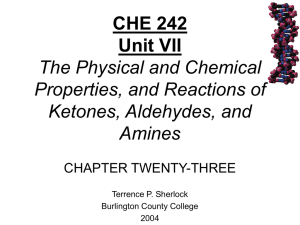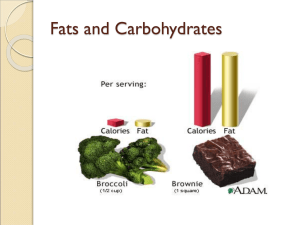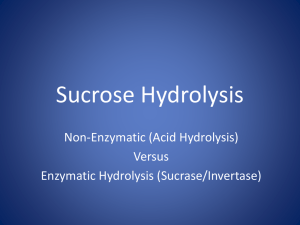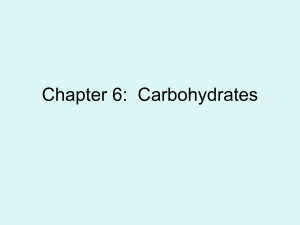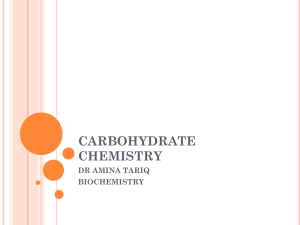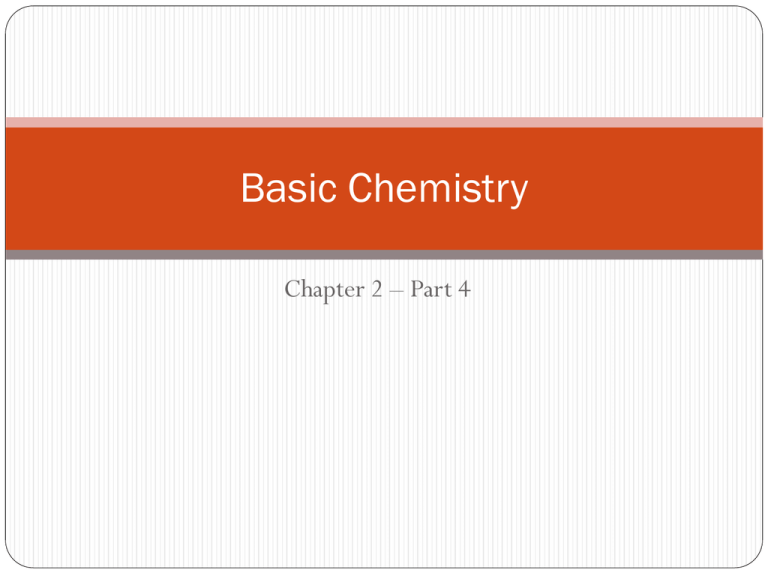
Basic Chemistry
Chapter 2 – Part 4
Carbohydrates
Carbohydrates - Compounds made up of carbon,
hydrogen, and oxygen atoms
Usually in a ratio of 1 : 2 : 1.
Examples: sugars and starches.
Classification of Sugars
1. Monosaccharides
2. Disaccharides
3. Polysaccharides
Monosaccharides
Monosaccharides - Single sugar
molecules
Referred to as simple sugars
Single-chain or single-ring structures
Contain 3 to 7 carbon atoms
Examples in the body: Glucose, Galactose, Fructose,
ribose, and deoxyribose
Glucose (also called blood sugar) is the universal cellular fuel.
Fructose and galactose are converted to glucose for use by
body cells.
Ribose and deoxyribose form part of the structure of nucleic
acids.
Disaccharides
Disaccharides – Double sugar molecules
Formed when two simple sugars are joined by a synthesis
reaction known as dehydration synthesis.
In this reaction, a water molecule is lost as the bond forms.
Examples:
Glucose + Fructose = Sucrose (cane sugar)
Glucose + Galactose = Lactose (found in milk)
Glucose + Glucose = Maltose (malt sugar)
Disaccharides
Double sugars are too large to pass through cell
membranes.
They must be broken down (digested) to their
monosaccharide unit to be absorbed by the blood.
This is accomplished by hydrolysis.
As a water molecule is added to each bond, the bond is
broken, and the simple sugar units are released.
Polysaccharides
Polysaccharides – More than
two sugar molecules
Because they are large, insoluble
molecules, they:
Are ideal storage products.
Lack the sweetness of the simple
and double sugars.
Examples:
Starch - The storage polysaccharide formed by plants; Humans
ingest it in the form of “starchy” foods such as potatoes and carrots.
Glycogen – Polysaccharide found in animal tissues (mainly in the
liver and muscles); Formed by linked glucose units.
Uses of Carbohydrates
Living things use carbohydrates as:
1.Main source of energy (starches and sugars)
2.Plants and some animals also use carbohydrates for
structural purposes (only 1-2% of animal cell mass)
o Some sugars are found in our genes.
o Some sugars are attached to outer surfaces of cell
membranes, where they act as road signs to guide cellular
interactions.
How Do We Get Energy From Glucose?
1. When glucose is oxidized
(combined with oxygen) in
a complex set of chemical
reactions, it is broken down
to carbon dioxide and water.
2. Some of the energy released
as the glucose bonds are broken is trapped in the
bonds of high-energy ATP molecules.
3. If not immediately needed for ATP synthesis,
carbohydrates are converted to glycogen or fat and
stored.
Lipids
Common categories of lipids are:
1. Neutral Fats (Triglycerides)
2. Phospholipids
3. Steroids
Enter the body in the form of fat-
marbled meats, egg yolks, milk
products, and oils.
Generally not soluble in water but
readily dissolve in other lipids and other
in organic solvents such as alcohol and
acetone.
General Structure of Lipids
Large and diverse group of organic
compounds.
Contains carbon, hydrogen, and
oxygen atoms, but in lipids, carbon
and hydrogen atoms far outnumber
oxygen atoms.
Example: The formula for a typical
fat named tristearin is C57H110O6.
Neutral Fats
Neutral Fats or
Triglycerides contain the
following structure:
Glycerol molecule + 3 fatty
acids
The glycerol backbone is
the same in all neutral fats,
but the fatty acid chains vary
and results in different kinds
of neutral fats.
Exists as a solid or liquid.
Saturated and Unsaturated Lipids
Saturated - If each carbon atom in a lipid's fatty acid chains
is joined to another carbon atom by a single bond.
“Saturated” is used because the fatty acids contain the
maximum possible number of hydrogen atoms.
Animal fats tend to be saturated.
Unsaturated - If there is at least one carbon-carbon double
bond or triple bond in a fatty acid.
Have the ability to bind with more hydrogen atoms or atoms
of a different type.
Plant oils tend to be unsaturated (such as corn oil, canola
oil, sesame oil, and peanut oil).
Saturated and Unsaturated Fatty Acids
Function of Neutral Fats
Represent the body’s most abundant and concentrated
source of usable energy.
When they are oxidized, they yield large amounts of
energy.
They are stored chiefly in fat deposits beneath the skin
and around organs, where they:
1. Help insulate the body
2. Protect deeper body tissues from
heat loss and bumps.
Phospholipids
Glycerol molecule + 2 fatty acids + phosphorus-
containing group
The phosphorus-containing portion (the “head”) bears an
electrical charge and therefore gives phospholipids special
chemical properties and polarity.
The charged region attracts and interacts with water and ions,
but the fatty acid chains
(the “tail”) do not.
Allows cells to be selective
about what may enter or
leave the membrane.
Steroids
Steroids – Basically flat molecules
formed by four interlocking rings.
Cholesterol is the single most important steroid molecule.
Enters the body in animal products such as meat, eggs, and
cheese.
A certain amount is also made by the liver, regardless of
dietary intake.
Uses:
Found in all cell membranes (particularly abundant in the
brain).
Raw material used to form vitamin D, some hormones (sex
hormones and cortisol), and bile salts.
Saturated Fats
Saturated fats and cholesterol have been
implicated as substances that encourage
atherosclerosis (deposit of fatty
substances in our artery walls) and
eventual arteriosclerosis (hardening of
the arteries).
As a result olive oil and liquid spreads
made from polyunsaturated fats are
being promoted as good-tasting
substitutes that do not damage our
arteries.






